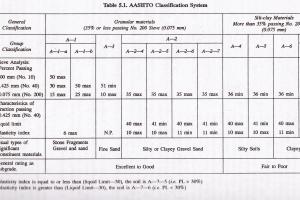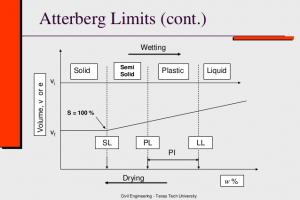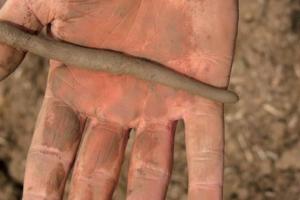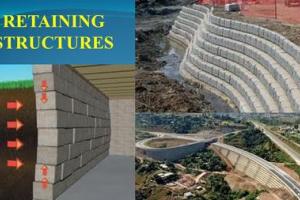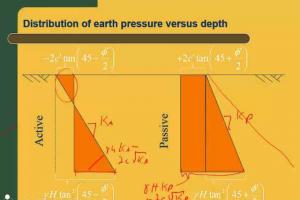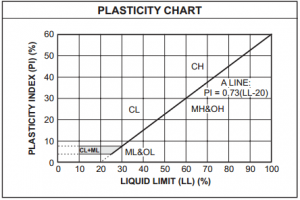Unified Soil Classification System and Its Engineering Applications

Unified Soil Classification System (USCS)
The Unified Soil Classification System is based on the airfield soil classification system developed by Casagrande during World War II (in 1948). With some modifications, it was jointly adopted by several U.S. government agencies in 1952. Additional refinements were made and it is currently standardized as ASTM D 2487-93. It is used in the U.S. and much of the world for geotechnical work other than roads and highways (For which AASHTO Soil Classification is used).
USCS Classification System
The USCS classifies soils into various groups based on their particle size distribution, mineralogy, and plasticity characteristics. The system uses two-letter symbols to represent the major soil groups and additional symbols to indicate specific properties. Here are the major soil groups recognized by the USCS:
-
Coarse-Grained Soils:
- Coarse-grained soils have a high proportion of larger particles such as sand and gravel.
- Gravels (G): Composed of particles larger than 4.75 mm (No. 4 sieve).
- Sands (S): Composed of particles ranging from 0.075 mm (No. 200 sieve) to 4.75 mm (No. 4 sieve).
-
Fine-Grained Soils:
- Fine-grained soils have a high proportion of smaller particles such as clay and silt.
- Silts (M): Composed of fine particles ranging from 0.075 mm (No. 200 sieve) to 0.002 mm (No. 10 sieve).
- Clays (C): Composed of particles smaller than 0.002 mm (No. 10 sieve).
-
Organic Soils:
- Organic (O): Composed of organic materials such as peat or muck.
In addition to the major soil groups, the USCS includes several modifiers to indicate specific properties or characteristics of the soils. Some of the commonly used modifiers include:
- Well-graded (W): Indicates a wide range of particle sizes within a soil.
- Poorly graded (P): Indicates a narrow range of particle sizes within a soil.
- High plasticity (H): Indicates high clay content and high plasticity.
- Low plasticity (L): Indicates low clay content and low plasticity.
- Elastic (E): Indicates that the soil behaves elastically under loading.
- Inorganic (I): Indicates that the soil is predominantly composed of inorganic materials.
In the unified system soils are designated by a two-letter symbol: the first identifies the primary component of the soil, and the second describes its grain size or plasticity characteristics. For example, poorly graded sand is designated SP and low plasticity clay is CL. Five first-letter symbols are used:
- G for gravel
- S for sand
- M for silt
- C for clay
- O for organic soil
Clean sands and gravels (having less than 5% passing the No. 200 sieve in Sieve Analysis) are given a second letter P if poorly graded or W if well graded. Sands and gravels with more than 12% by weight passing the No. 200 sieve are given a second letter M if the fines are silty or C if the fines are clayey. Sands and gravels having between 5 and 12% are given dual classifications such as SP-SM. Silts, clays, and organic soils are given the second letter H or L to designate high or low plasticity. The specific rules for classification are summarized as follows and described in detail in ASTM D 2487.
- Organic soils are distinguished by a dark brown to black color, an organic odor, and visible fibrous matter.
- For soils that are not notably organic, the first step in classification is to consider the percentage passing the No. 200 sieve.
- If less than 50% of the soil passes the No. 200 sieve, the soil is coarse-grained, and the first letter will be G or S;
- if more than 50% passes the No. 200 sieve, the soil is fine-grained and the first letter will be M or C.
In Unified Soil Classification System, for coarse-grained soils, the proportions of sand and gravel in the coarse fraction (not the total sample) determine the first letter of the classification symbol. The coarse fraction is that portion of the total sample retained on a No. 200 sieve. If more than half of the coarse fraction is gravel (retained on the No. 4 sieve), the soil is gravel and the first letter symbol is G. If more than half of the coarse fraction is sand, the soil is sand and the first letter symbol is S. For sands and gravels the second letter of the classification is based on gradation for clean sands and gravels and plasticity of the fines for sands and gravels with fines.
For clean sands (less than 5% passing the No. 200 sieve), the USCS classification is well-graded sand (SW) if C ≥ 6 and 1 £ Cc £ 3. Both of these criteria must be met for the soil to be SW, otherwise, the classification is poorly graded sand (SP). Clean gravels (less than 5% passing the No. 200 sieve) are classified as well-graded gravel (GW) if Cu ≥ 4 and 1 £ Cc £ 3. If both criteria are not met, the soil is poorly graded gravel (GP). For sands and gravels where more than 12% of the total sample passes the No. 200 sieve, the soil is clayey sand (SC), clayey gravel (GC), silty sand (SM), or silty gravel (GM).
The second letter is assigned based on whether the fines classify as clay (C) or silt (M) as described for fine-grained soils below. For sands and gravels having between 5 and 12% of the total sample passing the No. 200 sieve, both the gradation and plasticity characteristics must be evaluated and the soil is given a dual classification such as SP-SM, SP-SC, GW-GC, etc. The first symbol is always based on gradation, whereas the second is always based on plasticity. For fine-grained and organic soils, classification in the unified system is based on Atterberg limits determined by the fraction passing the No. 40 sieve. The liquid limit and plasticity index in the Unified Soil Classification System are determined and plotted on the plasticity chart. The vertical line at LL = 50 separates high-plasticity soils from low-plasticity soils. The A-line separates clay from silt. The equation of the A-line is
PI = 0.73 (LL – 20)

The U-line is not used in Unified Soil Classification System but is an upper boundary of expected results for natural soils. Values plotting above the U-line should be checked for errors. Inorganic soils with liquid limits below 50 that plot above the A-line and have PI values greater than 7 are lean clays and are designated CL; those with liquid limits above 50 that plot above the A-line is fat clays and are designated CH. Inorganic soils with liquid limits below 50 that plot below the A-line are silt and are designated ML; those with liquid limits above 50 that plot below the A-line are elastic silts and are designated MH.
The plasticity chart has a shaded area; soils that plot in this area (above the A-line with PI values between 4 and 7) are silty clay and are given the dual symbol CL-ML. If the soil under consideration is the fine component of dual-classified sand or gravel, the soil is classified as SM-SC or GM-GC. Soils with sufficient organic contents to influence properties that have liquid limits below 50 are classified as OL; those with liquid limits above 50 are classified as OH. Soils that are predominantly organic, with visible vegetable tissue, are termed peat and given the designation Pt.
USCS Applications in Engineering
The Unified Soil Classification System is useful in the design and construction of various civil engineering projects, such as foundation design, earthworks, and soil stabilization. It provides a standardized language for communicating soil properties, which helps engineers and geologists to better understand and analyze soil behavior. Here are some key applications of the USCS in engineering:
- Foundation Design: The USCS classification helps engineers assess the soil's properties and behavior to determine suitable foundation types and design parameters. Different soil types have varying bearing capacities and settlement characteristics, which influence foundation design decisions.
- Earthwork and Excavation: The USCS classification is used to assess the suitability of soils for various earthwork activities, such as cut and fill operations, embankments, and slopes. It provides information about the soil's stability, compaction requirements, and potential for erosion.
- Slope Stability Analysis: Understanding the properties of different soil types is crucial in assessing slope stability. The USCS classification helps engineers identify cohesive and non-cohesive soils, which play a significant role in slope stability analysis and the design of stabilization measures.
- Retaining Structures: The USCS classification is used to evaluate soil properties for the design of retaining walls, sheet piles, and other types of structures that resist lateral soil pressure. Soil types with different cohesion and angle of internal friction have varying behavior under lateral loads.
- Pavement Design: The USCS classification assists in characterizing the subgrade soil conditions for pavement design. It helps engineers determine the strength and compressibility of the soil beneath the pavement layers, which affects the design of flexible or rigid pavements.
- Ground Improvement Techniques: The USCS classification guides engineers in selecting appropriate ground improvement techniques based on soil properties. For example, certain soil types may require stabilization through methods like soil reinforcement, compaction, or chemical treatment.
- Geotechnical Investigations: During site investigations, soil samples are collected and classified using the USCS. This information helps engineers understand the subsurface conditions, groundwater levels, and soil properties for a thorough geotechnical assessment.
- Construction Quality Control: The USCS classification is used for quality control during construction activities. It helps in ensuring that the specified soil requirements are met, such as compaction levels, moisture content, and grading limits.
Overall, the USCS provides a standardized system for classifying soils, allowing engineers to make informed decisions in various geotechnical engineering applications. It helps evaluate soil behavior, determine design parameters, and select appropriate construction methods to ensure the safety and stability of engineering projects.



